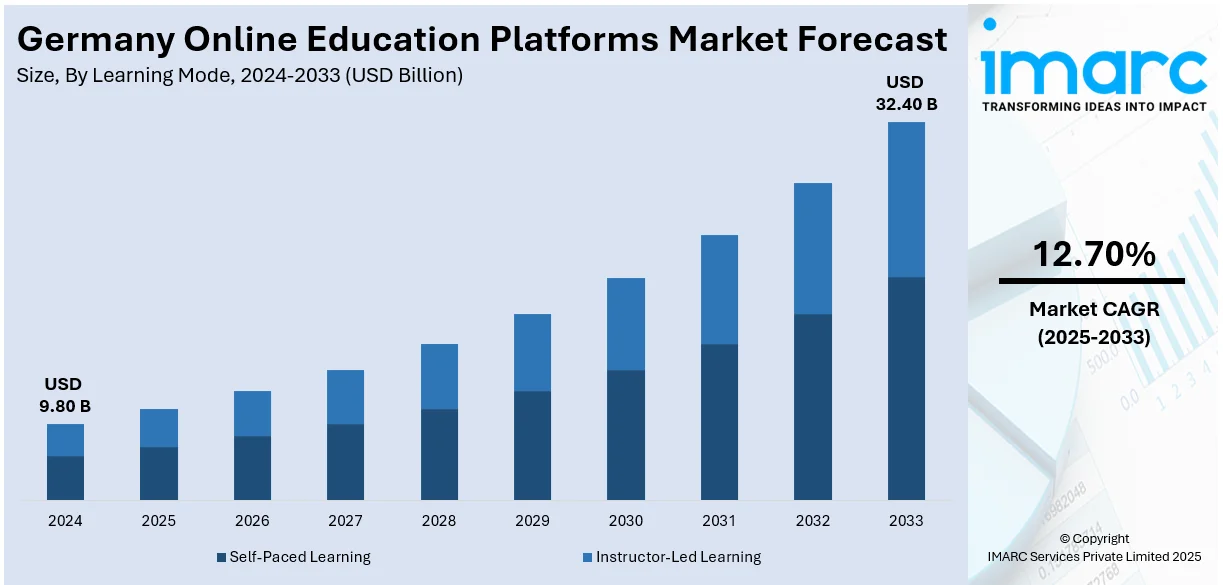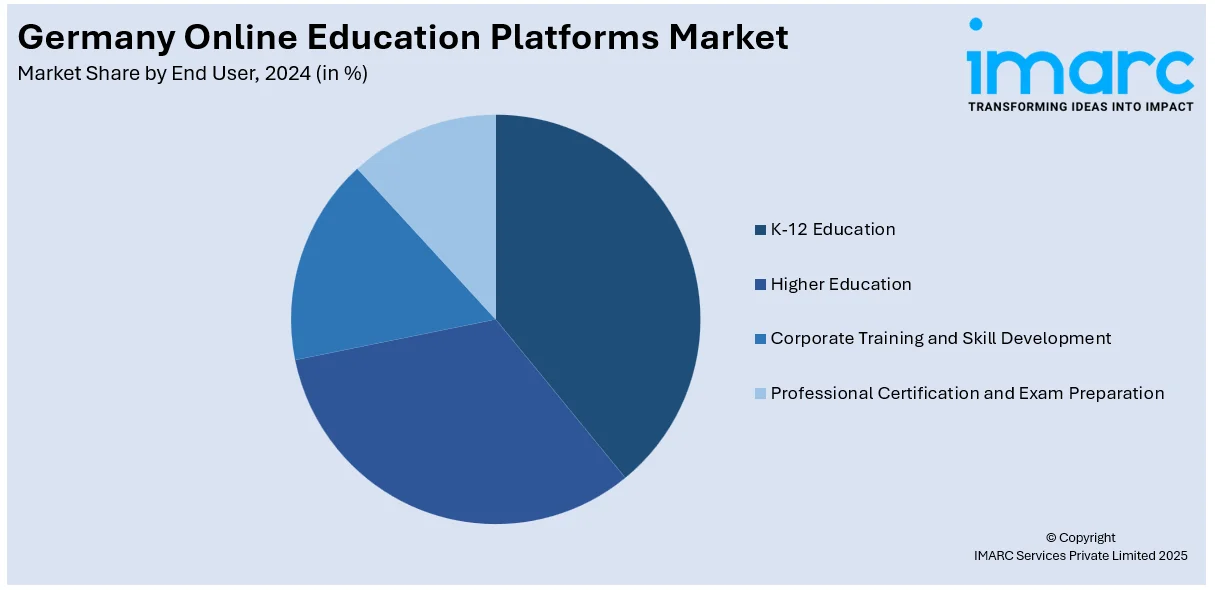
Germany Online Education Platforms Market Size, Share, Trends and Forecast by Learning Mode, Platform Type, Business Model, End User and Region, 2025-2033
Germany Online Education Platforms Market Overview:
The Germany online education platforms market size reached USD 9.80 Billion in 2024. Looking forward, IMARC Group expects the market to reach USD 32.40 Billion by 2033, exhibiting a growth rate (CAGR) of 12.70% during 2025-2033. The market is driven by the rising digital connectivity, as learners are preferring mobile-friendly platforms, along with the integration of artificial intelligence (AI), which is enabling personalized learning experiences and optimizing the learning process in the country.
|
Report Attribute
|
Key Statistics
|
|---|---|
|
Base Year
|
2024
|
|
Forecast Years
|
2025-2033
|
|
Historical Years
|
2019-2024
|
| Market Size in 2024 | USD 9.80 Billion |
| Market Forecast in 2033 | USD 32.40 Billion |
| Market Growth Rate 2025-2033 | 12.70% |
Germany Online Education Platforms Market Trends:
Expansion of Mobile Learning
As per the International Trade Administration, in 2023, the smartphone penetration rate of Germany reached 90.1% while the internet penetration rate reached 93.1%. The growth of the Germany online education platforms market is being propelled by enhanced digital connectivity, with students preferring mobile-compliant platforms for flexibility and convenience. It allows students to access various courses on mobile phones while commuting, taking breaks, or squeezing in a few hours whenever they find free time without being tied down by a specific schedule. Apart from this, the platforms for online education are improving their interface toward mobile-friendly use. Developers are also concentrating on building fun and easy-to-use apps and websites that meet a smartphone-driven user's preferences. This change allows platforms to cater to a wider range of users, especially those who appreciate convenience and on-demand access to learning materials. E-Learning programs in the corporate sector are also becoming mobile, allowing employees to complete training modules using mobile apps. This minimizes the time spent away from work and facilitates continuous professional growth. In addition, mobile learning forms a basis for the microlearning approach, where users participate in short, focused lessons that small devices accommodate. Furthermore, the use of interactive components, such as quizzes, video lessons, and real-time feedback on mobile platforms, enhances engagement. Increased motivation among learners comes from being able to track their progress and receive instant feedback on performance, making learning much more dynamic. Gamification enhances the appeal of mobile learning by transforming educational tasks into rewarding experiences that engage users, promoting the development of the Germany online education platforms market share.

Increasing Integration of Artificial Intelligence (AI)
AI has become an important feature in the online education platform for personalizing student learning experiences that adapt to a learner's requirements, preferences, and progress. The recommendation by AI systems of tailored courses and study materials, and provision of real-time feedback based on the analysis of user behavior and performance keep learners engaged and allow them to perform well. On top of that, AI-assisted tools like virtual tutors, chatbots, and automated assessments facilitate learning with considerably reduced human intervention while sustaining various levels of support. This kind of technology is especially helpful in handling large volumes of learners so that the platforms can then scale their services without sacrificing quality. AI's capability for analyzing enormous amounts of data is also contributing to course content improvements by showing possible areas for knowledge gaps and proposing materials for upgrades in real-time.AI is also reforming content curation and delivery, creating an attractive Germany online education platforms market outlook. AI algorithms can observe and record patterns of learning to adjust the difficulty of lessons or assessments dynamically based on the learner's progress, thus allowing a more individualized path of learning. The process of customizing content according to the learner's skill allows the user to engage with material that is neither boringly easy nor aggravatingly difficult. Besides this, AI-based platforms use natural language processing for voice command and two-way interactions, enabling rich interactivity and intuitive interaction in the learning process. Apart from this, the government's authorities are undertaking several steps to propagate AI technology advancement across sectors. They also plan to invest nearly €1.6 billion in A.I. development by 2025, consequently fueling further innovations and growing its application in the country.
Germany Online Education Platforms Market Segmentation:
IMARC Group provides an analysis of the key trends in each segment of the market, along with forecasts at the regional level for 2025-2033. Our report has categorized the market based on learning mode, platform type, business model, and end user.
Learning Mode Insights:
- Self-Paced Learning
- Instructor-Led Learning
The report has provided a detailed breakup and analysis of the market based on the learning mode. This includes self-paced learning and instructor-led learning.
Platform Type Insights:
- Massive Open Online Courses (MOOCs)
- Learning Management Systems (LMS)
- Virtual Classrooms
- Mobile Learning Apps
The report has provided a detailed breakup and analysis of the market based on the platform type. This includes massive open online courses (MOOCS), learning management systems (LMS), virtual classrooms, and mobile learning apps.
Business Model Insights:
- Subscription-Based
- Freemium
- One-Time Payment
The report has provided a detailed breakup and analysis of the market based on the business model. This includes subscription-based, freemium, and one-time payment.
End User Insights:

- K-12 Education
- Higher Education
- Corporate Training and Skill Development
- Professional Certification and Exam Preparation
The report has provided a detailed breakup and analysis of the market based on the end user. This includes K-12 education, higher education, corporate training and skill development, and professional certification and exam preparation.
Regional Insights:
- Western Germany
- Southern Germany
- Eastern Germany
- Northern Germany
The report has also provided a comprehensive analysis of all the major regional markets, which include Western Germany, Southern Germany, Eastern Germany, and Northern Germany.
Competitive Landscape:
The market research report has also provided a comprehensive analysis of the competitive landscape. Competitive analysis such as market structure, key player positioning, top winning strategies, competitive dashboard, and company evaluation quadrant has been covered in the report. Also, detailed profiles of all major companies have been provided.
Germany Online Education Platforms Market News:
- June 2024: German-based digital education platform Lecturio acquired NEJM Healer from the New England Journal of Medicine (NEJM) Group, enhancing its clinical education capabilities by integrating clinical reasoning training into its medical education platform.
- May 2023: TUI Care Foundation launched the e-Academy, an online platform offering free and self-paced courses in tourism and sustainability, developed in collaboration with atingi and the German Development Agency (GIZ) as part of the TUI Academy programme.
Germany Online Education Platforms Market Report Coverage:
| Report Features | Details |
|---|---|
| Base Year of the Analysis | 2024 |
| Historical Period | 2019-2024 |
| Forecast Period | 2025-2033 |
| Units | Billion USD |
| Scope of the Report |
Exploration of Historical Trends and Market Outlook, Industry Catalysts and Challenges, Segment-Wise Historical and Future Market Assessment:
|
| Learning Modes Covered | Self-Paced Learning, Instructor-Led Learning |
| Platform Types Covered | Massive Open Online Courses (MOOCs), Learning Management Systems (LMS), Virtual Classrooms, Mobile Learning Apps |
| Business Models Covered | Subscription-Based, Freemium, One-Time Payment |
| End Users Covered | K-12 Education, Higher Education, Corporate Training and Skill Development, Professional Certification and Exam Preparation |
| Regions Covered | Western Germany, Southern Germany, Eastern Germany, Northern Germany |
| Customization Scope | 10% Free Customization |
| Post-Sale Analyst Support | 10-12 Weeks |
| Delivery Format | PDF and Excel through Email (We can also provide the editable version of the report in PPT/Word format on special request) |
Key Questions Answered in This Report:
- How has the Germany online education platforms market performed so far and how will it perform in the coming years?
- What is the breakup of the Germany online education platforms market on the basis of learning mode?
- What is the breakup of the Germany online education platforms market on the basis of platform type?
- What is the breakup of the Germany online education platforms market on the basis of business model?
- What is the breakup of the Germany online education platforms market on the basis of end user?
- What is the breakup of the Germany online education platforms market on the basis of region?
- What are the various stages in the value chain of the Germany online education platforms market?
- What are the key driving factors and challenges in the Germany online education platforms market?
- What is the structure of the Germany online education platforms market and who are the key players?
- What is the degree of competition in the Germany online education platforms market?
Key Benefits for Stakeholders:
- IMARC’s industry report offers a comprehensive quantitative analysis of various market segments, historical and current market trends, market forecasts, and dynamics of the Germany online education platforms market from 2019-2033.
- The research report provides the latest information on the market drivers, challenges, and opportunities in the Germany online education platforms market.
- Porter's five forces analysis assist stakeholders in assessing the impact of new entrants, competitive rivalry, supplier power, buyer power, and the threat of substitution. It helps stakeholders to analyze the level of competition within the Germany online education platforms industry and its attractiveness.
- Competitive landscape allows stakeholders to understand their competitive environment and provides an insight into the current positions of key players in the market.
Need more help?
- Speak to our experienced analysts for insights on the current market scenarios.
- Include additional segments and countries to customize the report as per your requirement.
- Gain an unparalleled competitive advantage in your domain by understanding how to utilize the report and positively impacting your operations and revenue.
- For further assistance, please connect with our analysts.
 Request Customization
Request Customization
 Speak to an Analyst
Speak to an Analyst
 Request Brochure
Request Brochure
 Inquire Before Buying
Inquire Before Buying




.webp)




.webp)












